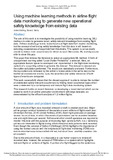JavaScript is disabled for your browser. Some features of this site may not work without it.
| dc.contributor.author | Oehling, Julian | |
| dc.contributor.author | Barry, David J. | |
| dc.date.accessioned | 2019-01-17T19:53:50Z | |
| dc.date.available | 2019-01-17T19:53:50Z | |
| dc.date.issued | 2019-01-15 | |
| dc.identifier.citation | Oehling J, Barry D. (2019) Using machine learning methods in airline flight data monitoring to generate new operational safety knowledge from existing data. Safety Science, Volume 114, April 2019, pp. 89-104 | en_UK |
| dc.identifier.issn | 0925-7535 | |
| dc.identifier.uri | https://doi.org/10.1016/j.ssci.2018.12.018 | |
| dc.identifier.uri | https://dspace.lib.cranfield.ac.uk/handle/1826/13830 | |
| dc.description.abstract | The aim of this work is to investigate the possibility of using machine learning (ML) methods in order to generate novel, safety-relevant knowledge from existing flight data. Airlines routinely generate vast amounts of flight data from routine monitoring, but the concept of extracting safety knowledge from this data is still based on detecting exceedances of expert-defined thresholds. This system is conceptually unable to detect novel occurrences for which no such filters exist. ML techniques are able to close this gap. This paper first reviews the literature to select an appropriate ML method. A form of unsupervised learning called “Local Outlier Probability” is selected. Next, an appropriate feature space is developed and implemented in the flight data monitoring system of a supporting airline to generate the dataset. This dataset is cleaned and the outlier calculation performed. The results are statistically analysed. Furthermore, the top outliers are reviewed by the airline’s review pilots in the same way as the traditional exceedance events. Last, the severities and safety relevance of both types of events are compared. This work successfully shows that the chosen approach is able to reduce the number of undetected safety-relevant occurrences by finding novel occurrence types which were undetected by a contemporary and mature flight data monitoring system. This research builds on recent literature by developing a novel method which can be scaled to work in an airline production environment with large datasets, as demonstrated by the efficient analysis of 1.2 million flights. | en_UK |
| dc.language.iso | en | en_UK |
| dc.publisher | Elsevier | en_UK |
| dc.rights | Attribution-NonCommercial-NoDerivatives 4.0 International | * |
| dc.rights.uri | http://creativecommons.org/licenses/by-nc-nd/4.0/ | * |
| dc.title | Using machine learning methods in airline flight data monitoring to generate new operational safety knowledge from existing data | en_UK |
| dc.type | Article | en_UK |
Files in this item
The following license files are associated with this item:
This item appears in the following Collection(s)
-
Staff publications (SATM) [4367]

